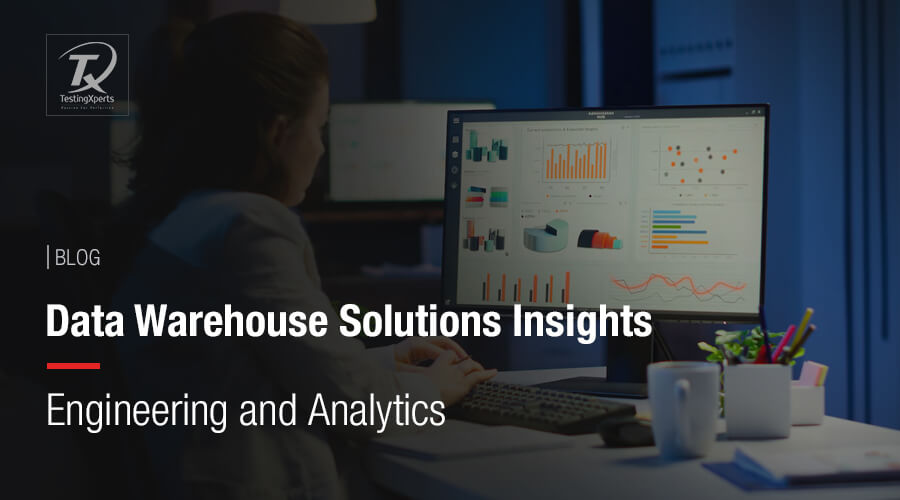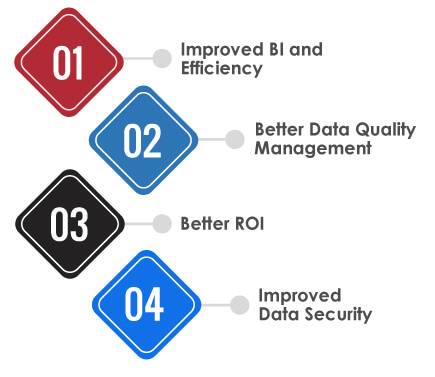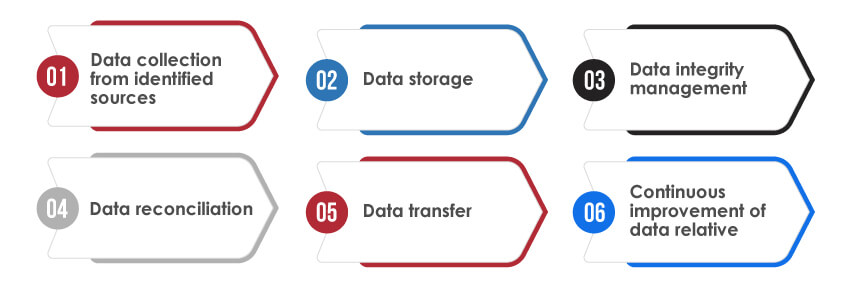
- Benefits of Data Warehouses
- Data Warehouse Architecture
- Data Engineering for Data Warehouses
- Data Analytics with Data Warehouses
- Why Partner with Tx for Data Warehouse Solution?
- Summary
Businesses understand the importance of having a flexible and reliable data foundation to improve their decision-making abilities and support BI. Data warehouse solutions serve as the backbone by offering a centralized repository to consolidate data from various sources. Businesses can quickly analyze and extract valuable insights from that data. It makes decision-making more proficient and boosts data management efficiency across multiple business environments.
What is a “data warehouse?” It is an enterprise data platform that companies leverage to analyze, and report structured and semi-structured data from various sources (POS transactions, CRM, marketing automation, and more). A data warehouse includes an analytical database, components, and procedures to support ad-hoc analysis and customer reporting, such as business applications, data pipelines, and queries. It is a core aspect of enterprise analytics that supports informed decision-making.
Organizations utilize various types of data warehouses for different purposes. But at the end of the day, they are structured according to the following formats:
- Data Mart: This small data warehouse analyzes and reports specific business aspects, such as departmental data.
- Virtual Data Warehouse: It separates databases, forming a virtual data warehouse that can be queried together.
- Enterprise Data Warehouse: A big data warehouse combines data from different sources across the organization.
Benefits of Data Warehouses

Over 60% of decision-makers witness “decision paralysis” in their business because of unorganized data and other issues. Data warehouses can resolve many of those issues. Let’s take a look at some of the benefits that businesses can receive:
Improved BI and Efficiency
Businesses generate a massive amount of data from different sources (purchasing trends, POS, pricing, customer data, etc.). The sheer volume can be overwhelming if left unattended, and storing it on multiple platforms comes with a cost. Data warehousing makes this easier by storing and organizing data in a centralized repository, allowing businesses to identify and reap its benefits through business intelligence solutions. It also reduces data management costs by placing data into one location rather than distributing it across multiple platforms and paying different vendors.
Better ROI
Businesses leveraging Oracle Autonomous Data Warehouse (ADW) solution achieve a return on investment (ROI) of 417% within five years. There are several reasons for this:
Better Data Quality Management
Nowadays, enterprises generate data rapidly. They need to ensure the data is updated and accurate per analytics platforms. When the data is spread across platforms, it is difficult for organizations to manage data quality. This issue can be resolved by combining scattered data into a data warehouse solution, making the cleansing process easy and cost-effective.
Improved data quality and reliability, enabling profitable decision-making.
Efficient reporting, development, and IT staff allocation.
Enhanced data security to reduce data security efforts and costs.
Reduced operational costs by improving resources and IT infrastructure usage.
Improved Data Security
In the current business scenario, security data has become a significant cybersecurity challenge for modern businesses. Data warehouse solutions allow enterprises to store data in one centralized location, making it easier to protect data. They can create user groups, limit permissions, and create individual-specific data access points within an organization.
Data Warehouse Architecture

A Data warehouse architecture is an organized framework that manages large data volumes from multiple sources. It allows businesses to efficiently store, retrieve, analyze, and use data for organizational intelligence and decision-making. This architecture creates a single source for large data volumes and then transforms it into information and then information into a knowledge base for analytical purposes. The data lifecycle includes:
- Data collection from identified sources
- Data storage
- Data integrity management
- Data reconciliation
- Data transfer
- Continuous improvement of data relative
As a business owner, your data warehouse architecture should support all the processes mentioned above and various other components of data lifecycle management. It should also be stakeholder-focused for marketing, finance, sales, etc. Each stakeholder needs different data analysis and modeling to streamline their decision-making. This includes users using different reporting and visualization tools and how apps utilize data for information and decisions.
Data Engineering for Data Warehouses

Data engineering is essential for designing, developing, and managing data warehouses, as they cannot function properly without data engineering. They cannot provide accurate business insights on their own. Here’s how data engineering supports data warehousing:
- Data Collection and Integration: Data engineering assists in designing systems to collect data from different sources and ensure it flows seamlessly into the warehouse. It helps integrate data ingestion pipelines to handle different data formats and large data volumes.
- Data Cleaning: Data cleaning and transformation must be done after data ingestion to fit data into the warehouse’s schema. This involves creating scripts and utilizing tools to automate the cleaning process, resolve inconsistencies, and standardize formats.
- Data Quality Assurance: Engineers check and validate data to ensure accuracy and completeness. This helps resolve errors and prevent faulty business decisions and analytics.
- Data Accessibility: Businesses can develop and maintain interfaces to allow end-users access and interact with data warehouses. This includes building APIs, UIs, etc., enabling easy and secure data access for analytics and reporting.
- Security and Compliance: Data engineers allow businesses to secure data through encryption, manage access controls, and monitor data usage. They also ensure that data warehousing complies with data protection standards.
Data Analytics with Data Warehouses

One of the major roles of data warehouses is to function as a central repository in big data analytics. Big data exists in multiple sources and formats, so data warehouses collect this information into a unified storage system. This enables easy data access, analysis, and management, useful for accurate insights. Data warehouses utilize various optimization techniques, like indexing, partitioning, etc., to ensure analytical queries can swiftly run, enabling businesses to derive real-time insights.
Data warehouses are highly scalable, which allows them to handle the ever-growing nature of big data without degrading performance. They can seamlessly scale structured or unstructured data organizations deal with as they grow. Its data integration and transformation capabilities support data analytics and enhance the reliability and accuracy of data-driven insights.
Big data analytics employs advanced techniques such as data mining, machine learning, and predictive analytics. Data warehouses offer a solid platform to perform these intricate tasks efficiently. Organizations can detect patterns, trends, and correlations in their large datasets by utilizing the substantial processing capabilities and storage solutions that data warehouses offer.
Why Partner with Tx for Data Warehouse Solution?

Tx has comprehensive experience in analytics testing, data warehouse solutions, and Big Data testing engagements and addresses the unique issues of DW and Big data analytics testing. We test DW applications at all levels, from the data source to the front-end BI applications. We offer customized data warehouse solutions that can expand with your dynamic data requirements while ensuring robust data infrastructure to support your business goals. Our testing approach includes:
- Cataloging source systems and understanding their format and structure will streamline data extraction.
- Maintain data integrity during extraction, then convert and clean data to fit the target schema and load it into data warehouses.
- Using industry-leading tools like MS-SSIS, AWS Glue, Google Cloud Dataflow, Informatica, and Azure Data Factory to integrate multiple data sources seamlessly.
- Defining robust three-tier architecture, customized data modeling, and intelligent data loading techniques that meet your data volume and complexity.
Summary
In the data-driven business world, data warehouse solutions are indispensable tools. They offer the infrastructure businesses require to turn vast data into actionable insights. The Data Warehouse’s role in centralizing data, supporting complex analytics, optimizing performance, handling security, and ensuring scalability makes it a core aspect of Big Data analytics strategies. However, to ensure the seamless performance and working of data warehouse solutions, you must partner with professional digital engineering and QA experts like Tx. We offer cost-effective and customized solutions for your DW/BI testing needs. To know more, contact our experts now.
Discover more
Get in Touch
Stay Updated
Subscribe for more info




